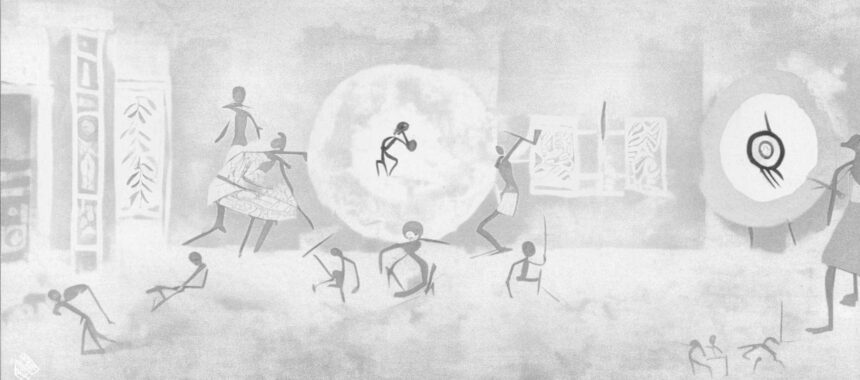Warli art is a 400 year old tribal art which originated in a village by the same name in Maharashtra, a state in western India. The beauty of this two-dimensional style of painting lies in its simplicity of technique and the stories that each piece of Warli art tells. The Warli tribe believed that nature provided for everything and liked to talk about the cycle of birth and death through their paintings.
Though we see Warli art in so many places and objects today, traditionally it was never meant to be preserved or contemplated. It started with women of the household, or the village, painting ochre colored walls of mud huts with white paint made of rice flour mixed with gum and water. They would use a chewed bamboo reed to paint figures on a background of cow dung and red earth. These paintings were typically done during preparations for a wedding ceremony, and the art depicted stories and lessons for the newly weds. Over time the paintings would fade away naturally. They were also done at births and to protect crops and houses from evil spirits. The focus of this rudimentary iconography was always the act and time of the painting and not any aesthetics.
Art that tells stories
Warli art does not have any religious symbols or holy figures. It depicts day-to-day scenes of women nursing, men working in the rice fields, etc. Farming was their mainstay and key source of food for the tribe and they had great respect for nature and the resources it provided for sustenance. The Warli people believe in harmony between nature and man, and these beliefs are often reflected in their paintings.
Warli motifs and technique
Warli artists paint in an endless variety of three simple geometric shapes that constitute a basic graphic vocabulary: the circle (inspired by observations of nature especially the sun and the moon), the square (indicating a sacred enclosure) and the triangle (used to represent the human body: two triangles joined at the tip). A bamboo stick is used as a paint brush, and white color (made of rice powder mixed with gum) is used for painting against a dark colored background.
The motifs reflect the life and aspirations of the tribal people, their sacred rituals, and the harmony with nature. Warli paintings are almost animated by a whole network of tiny disjointed lines giving the impression of movement. It is time-consuming, minutely detailed work used to tell a mythological tale appealing to earthly and heavenly powers.
Scenes portraying hunting, fishing and farming, festivals and dances, trees and animals surround the central motif in these paintings. Created mostly in white with the occasional dash of red or even yellow, Warli artwork interestingly resembles pre-historic cave paintings.
Warli in modern times
Of course, today you are likely to come across Warli paintings with cars and trains painted as well. No matter what the iconography used in a Warli painting, there is a story waiting to be told of the spiritual connections between earth and humans, the formation of the world, animals, celebration, witchcraft, deforestation, rice and animals too.
Now portrayed on canvas, Warli art has lost its brief and ritualistic nature though it still maintains a spirit of ancient tradition. The intricate geometric patterns of flowers, wedding rituals, hunting scenes and other everyday activities are popular among fashion designers and brands manufacturing bags, purses, lamps, showpieces, penholders, drinkware etc. Only now acrylic supplements the natural materials used.
The popularity of Warli art has led to it being shown in exhibitions in Paris (at the Musée du Quai Branly and the Fondation Cartier) and Lyon, where a renowned artist, Shatanram Tumbda, painted a large fresco on the front of the Musée Urbain Tony Garnier. In 2016, a group of Japanese artists adopted the Ganjad village in India in an effort to preserve Warli art, and have also been constructing huts from cow dung, mud and bamboo sticks to promote painting on the walls.
In a world of excesses, simplicity is a rarity. So, purchasing and promoting Warli art seems like a fitting tribute to this unique art form. And we can all learn a thing or two from their way of living.
About the author: Sushmita Vobbilisetty is the concept creator at Chitrapata. She has a deep understanding of old masters, modern, and contemporary artworks. Sushmita is an expert in evaluating the market value and fair value of art based on heritage, availability, sell-through rate, market performance over time, secondary sales track record, and other key factors. Sushmita frequently predicts the bidding prices for day sales and evening auctions hosted by leading art houses.
About us: Chitrapata is a digital atelier with an in-house generative art technology platform enhanced with machine learning and artificial intelligence capabilities. Our vision is to spark thoughts, conversations, and debates among different groups. Visit “About us” section to know more about our philosophy, vision, bio, artist statement, story and technology process.
Image credit: DreamStudio AI, StableDiffusion.

